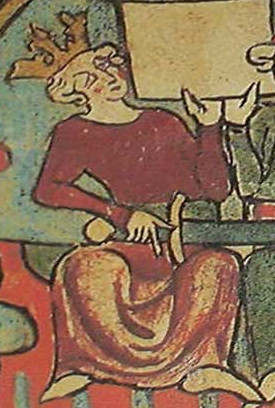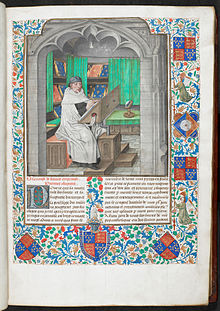This article is a list of the literary events and publications in the 15th century.

Vincent of Beauvais was a Dominican friar at the Cistercian monastery of Royaumont Abbey, France. He is known mostly for his Speculum Maius, a major work of compilation that was widely read in the Middle Ages. Often retroactively described as an encyclopedia or as a florilegium, his text exists as a core example of brief compendiums produced in medieval Europe.

Encyclopedism is an outlook that aims to include a wide range of knowledge in a single work. The term covers both encyclopedias themselves and related genres in which comprehensiveness is a notable feature. The word encyclopedia is a Latinization of the Greek enkýklios paideía, which means all-around education. The encyclopedia is "one of the few generalizing influences in a world of overspecialization. It serves to recall that knowledge has unity," according to Louis Shores, editor of Collier's Encyclopedia. It should not be "a miscellany, but a concentration, a clarification, and a synthesis", according to British writer H. G. Wells.
Orm, OSA, also known as Ormin, was an Augustinian canon from south Lincolnshire who wrote the Ormulum, a collection of verse homilies that is the oldest English autograph and one of the most significant records of Middle English. His work is a successful example of homiletics translating Latin learning to balance the needs of his fellow canons, who likely spoke Anglo-Norman French, with those of lay English-speaking audiences.
Mirrors for princes or mirrors of princes was a literary genre of didactic political writings throughout the Middle Ages and the Renaissance. It was part of the broader speculum or mirror literature genre.

Amis et Amiles is an old French romance based on a widespread legend of friendship and sacrifice. In its earlier and simpler form it is the story of two friends, one of whom, Amis, was sick with leprosy because he had committed perjury to save his friend. A vision informed him that he could only be cured by bathing in the blood of Amiles's children. When Amiles learnt this he killed the children, who were, however, miraculously restored to life after the cure of Amis.
Apology of al-Kindi is a medieval theological polemic making a case for Christianity and drawing attention to alleged flaws in Islam. The word "apology" is a translation of the Arabic word رسالة, and it is used in the sense of apologetics.

Avery Architectural and Fine Arts Library, the world's largest architecture library, is located in Avery Hall on the Morningside Heights campus of Columbia University in New York City. Serving Columbia's Graduate School of Architecture, Planning and Preservation and the Department of Art History and Archaeology, Avery Library collects books and periodicals in architecture, historic preservation, art history, painting, sculpting, graphic arts, decorative arts, city planning, real estate, and archaeology, as well as archival materials primarily documenting 19th- and 20th-century American architects and architecture. The architectural, fine arts, Ware, and archival collections are non-circulating. The Avery-LC Collection, primarily newer print books, does circulate.

The cartographic Renaissance of the sixteenth century in Europe was based on a rapid increase in geographical knowledge sourced from exploration and discovery, and the European map of the world "had literally doubled in size within just over a century." Especially in the important trading centers of Rome and Venice, many individual maps were printed in Italy from about 1544. Each publisher worked independently, producing maps based upon his own customers' needs. These maps often varied greatly in size.

The riddarasögur are Norse prose sagas of the romance genre. Starting in the thirteenth century with Norse translations of French chansons de geste and Latin romances and histories, the genre expanded in Iceland to indigenous creations in a similar style.

The Mirror of Simple Souls is an early 14th-century work of Christian mysticism by Marguerite Porete dealing with the workings of Divine Love.
Love in this book layeth to souls the touches of his divine works privily hid under dark speech, so that they should taste the deeper draughts of his love and drink.

The Speculum Humanae Salvationis or Mirror of Human Salvation was a bestselling, anonymously illustrated work of popular theology in the late Middle Ages, part of the genre of encyclopedic speculum literature, in this case concentrating on the medieval theory of typology, whereby the events of the Old Testament prefigured or foretold the events of the New Testament. The original version is in rhyming Latin verse, and contains a series of New Testament events each with three Old Testament ones that prefigure it. It is one of the most common books found as an illuminated manuscript, and also in early printing in both blockbook and incunabulum forms.

Jean Miélot, also Jehan, was an author, translator, manuscript illuminator, scribe and priest, who served as secretary to Philip the Good, Duke of Burgundy from 1449 to Philip's death in 1467, and then to his son Charles the Bold. He also served as chaplain to Louis of Luxembourg, Count of St. Pol from 1468, after Philip's death. He was mainly employed in the production of de luxe illuminated manuscripts for Philip's library. He translated many works, both religious and secular, from Latin or Italian into French, as well as writing or compiling books himself, and composing verse. Between his own writings and his translations he produced some twenty-two works whilst working for Philip, which were widely disseminated, many being given printed editions in the years after his death, and influenced the development of French prose style.

The Speculum maius or "Greater Mirror" was a major encyclopedia of the Middle Ages written by Vincent of Beauvais in the 13th century. It was a great compendium of all knowledge of the time. The work seems to have consisted of three parts: the Speculum Naturale, Speculum Doctrinale and Speculum Historiale. However, all the printed editions include a fourth part, the Speculum Morale, added in the 14th century and mainly compiled from Thomas Aquinas, Stephen of Bourbon, and a few other contemporary writers.
Aernout van Buchel was a Dutch antiquarian and humanist, specialising in genealogy and heraldry.

Otia Imperialia is an early 13th-century encyclopedic work, the best known work of Gervase of Tilbury. It is an example of speculum literature. Also known as the "Book of Marvels", it primarily concerns the three fields of history, geography, and physics, but its credibility has been questioned by numerous scholars including philosopher Gottfried Leibniz, who was alerted to the fact that it contains many mythical stories. Its manner of writing is perhaps because the work was written to provide entertainment to Holy Roman Emperor Otto IV. However, many scholars consider it a very important work in that it "recognizes the correctness of the papal claims in the conflict between Church and Empire." It was written between 1210 and 1214, although some give the dates as between 1209 and 1214 and numerous authors state it was published c.1211. These earlier dates must be questioned, however, as the Otia contains stories that take place in 1211 and later. S. E. Banks and James W. Binns, editors and translators of what is considered to be the definitive version of the Otia, suggest that the work was completed in the last years of Otto IV's life, saying "it seems most likely [...] that the work was sent to Otto sometime in 1215", due to the inclusion of the death of William the Lion, King of Scotland, which took place in 1214, and the fact that King John was still living while it was written; John died in 1216.

Encyclopedias have progressed from the beginning of history in written form, through medieval and modern times in print, and most recently, displayed on computer and distributed via computer networks.

Ambrogio Brambilla was an Italian engraver and cartographer, mainly active in Rome.
Rebecca Zorach is an art historian and Mary Jane Crowe Professor in Art and Art History at Northwestern University. Her work focuses on early modern European art, contemporary and activist art.

Jean de Vignay (c. 1282/1285 – c. 1350) was a French monk and translator. He translated from Latin into Old French for the French court, and his works survive in many illuminated manuscripts. They include two military manuals, a book on chess, parts of the New Testament, a travelogue and a chronicle.














